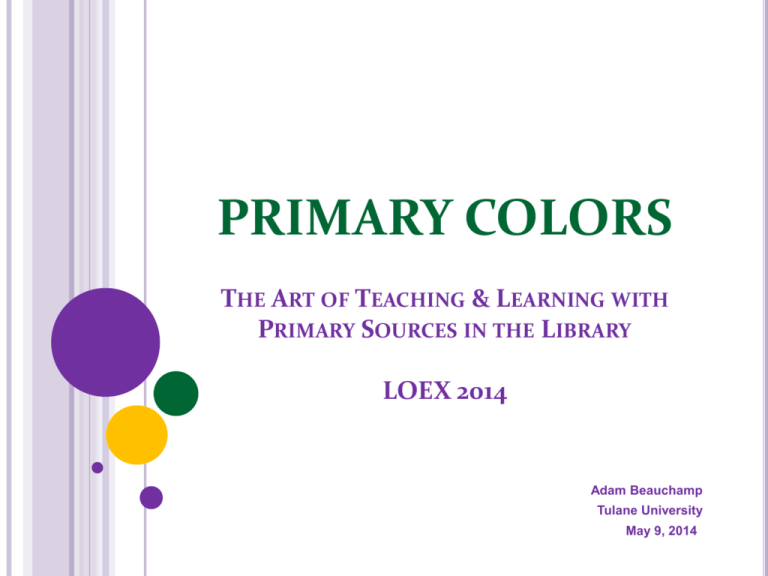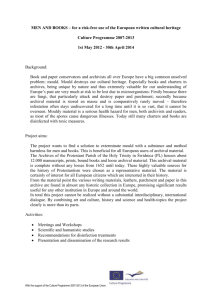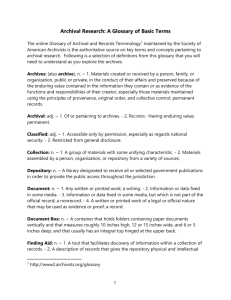Primary Colors: The Art of Teaching & Learning
advertisement

PRIMARY COLORS THE ART OF TEACHING & LEARNING WITH PRIMARY SOURCES IN THE LIBRARY LOEX 2014 Adam Beauchamp Tulane University May 9, 2014 Professor: “I am hoping to get them to think about using archival materials.” Students: “I need primary sources for my paper on gender roles in Victorian London. What databases do you have?” “Where can I find data for my research on Spaniards’ changing attitudes toward the afternoon siesta.” “Still a bit unclear on finding primary sources vs secondary. I know the difference between the two but not necessarily the best place to look for each. Students: “I need primary sources for my paper on gender roles in Victorian London. What databases do you have?” “Where can I find data for my research on Spaniards’ changing attitudes toward the afternoon siesta.” “Still a bit unclear on finding primary sources vs secondary. I know the difference between the two but not necessarily the best place to look for each. Professor: “They are not thinking about how to research this as a history paper…. Even one of the top students in the class is just kind of randomly looking for things about race in Cuba.” PEDAGOGY EXPERTS V. NOVICES Scholars Students Author intention Audience reaction Context Subtext Basic reading comprehension Recall Fact finding Sam Wineburg, Historical Thinking and Other Unnatural Acts (2001). ZONE OF PROXIMAL DEVELOPMENT Distance between what can be done independently, and what can be done with guidance New skills and knowledge happen first on the social level, and second on the individual level Lev Vygotsky, Mind in Society (1978). SCAFFOLDING SCAFFOLDING Relationship between expert and novice in the process of acquiring new skills Expert creates “reduction in degrees of freedom” Break down into steps Focus on one task/concept at a time Sequence of active learning methods Jerome Bruner, Actual Minds, Possible Worlds (1986). IN THE CLASSROOM SOCIOLOGY 3030: RESEARCH DESIGN “I am hoping to get them to think about using archival materials.” How do sociologists use “archival materials”? What types of archival materials have sociologists used? What types of archival materials does the library have? Which archival materials could be deployed in a one-shot session? THE SCAFFOLDED ONE-SHOT Modeling (precedes library session) Regular lecture & class readings Independent homework assignment Discussion Students report the types and uses of content in sociology articles they found Create list of content types on board Group Exercise Students work in teams, support one another’s learning Hands-on practice with the methodology A BUILDING FULL OF CONTENT FEEDBACK “I think it went really well ... I really think students ‘get it’ when they do something hands-on, and the wide range of materials you picked was fun and creative.” Post-session, 3/6/2013 “Based on their exam performance and in-class discussion following the content analysis exercise, this group of students definitely understood what it took for them to use these data for research. It has inspired me to do more hands-on exercises in class on other topics in the future.” End of semester, 5/8/2013 EXPANDING THE MODEL History professor: “A video of us should be on the Howard Tilton website. We had relatively inexperienced Tulane undergraduates poring over primary documents in three languages and muddling slowly through context and historical debates.” Political science student: “I learned about many more data sites available through the library. There is a lot of Census data…it was cool to look at our hometowns.” SELECT BIBLIOGRAPHY Bruner, Jerome S. Actual Minds, Possible Worlds. Cambridge, MA: Harvard University Press, 1983. Krippendorf, Klaus. 2010. “Content Analysis.” Pp. 234-36 in Encyclopedia of Research Design, edited by Neil J. Salkind. Thousand Oaks, CA: SAGE Publications. Vygotsky, Lev. 1978. Mind in Society. Cambridge, MA: Harvard University Press. Wineburg, Sam. 2001. Historical Thinking and Other Unnatural Acts. Philadelphia, PA: Temple University Press. Wood, David, Jerome S. Bruner, and Gail Ross. 1976. “The Role of Tutoring in Problem Solving.” Journal of Child Psychology and Psychiatry 17(1):89-100. Adam Beauchamp Research & Instruction Librarian Tulane University abeaucha@tulane.edu adambeauchamp.wordpress.com @delayedcajun







